
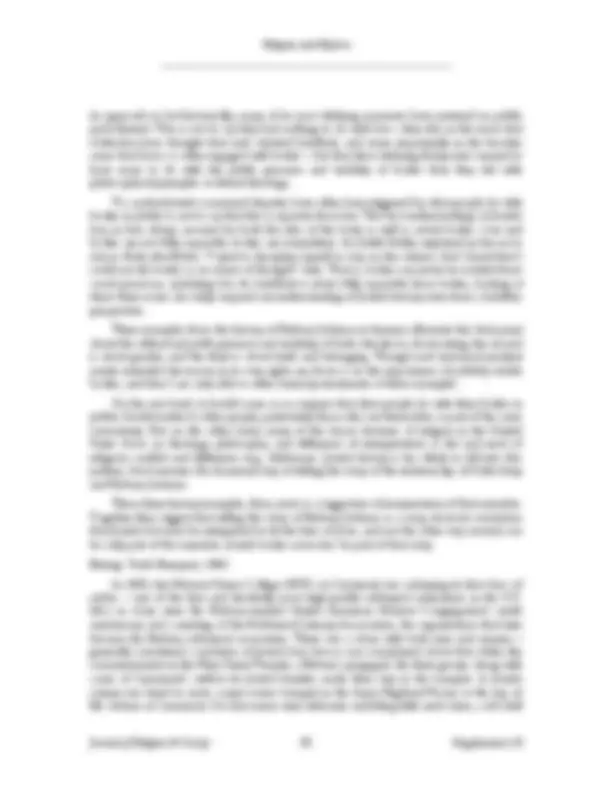
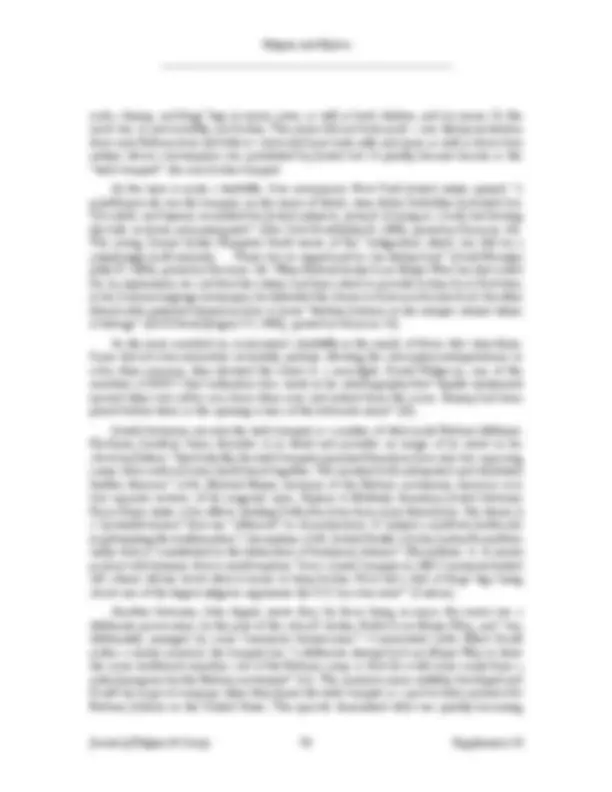
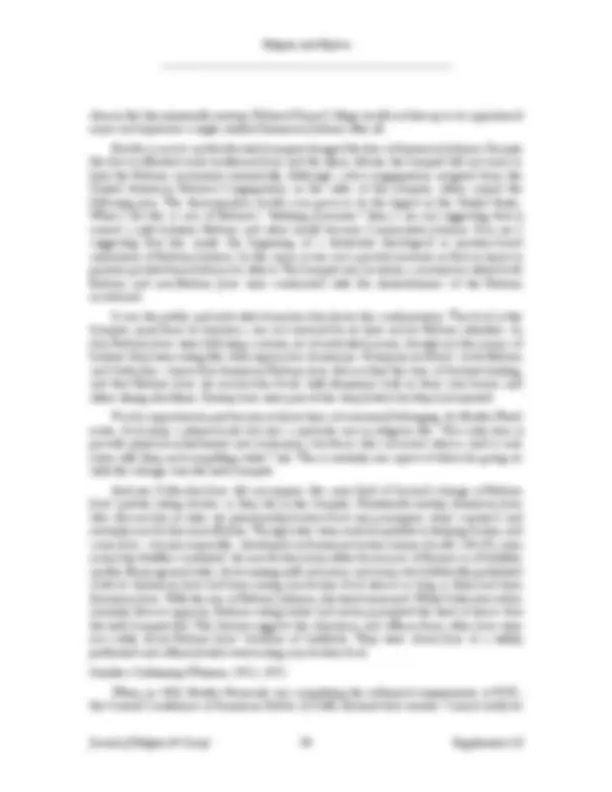
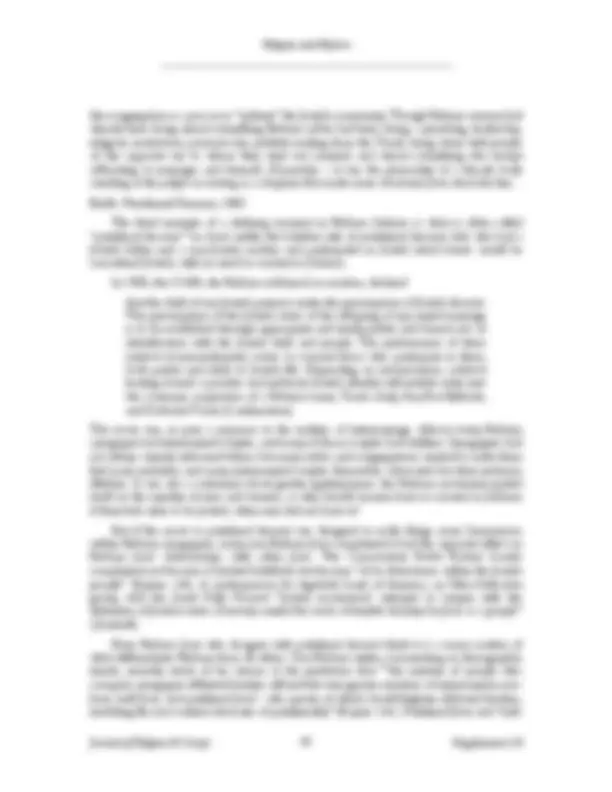
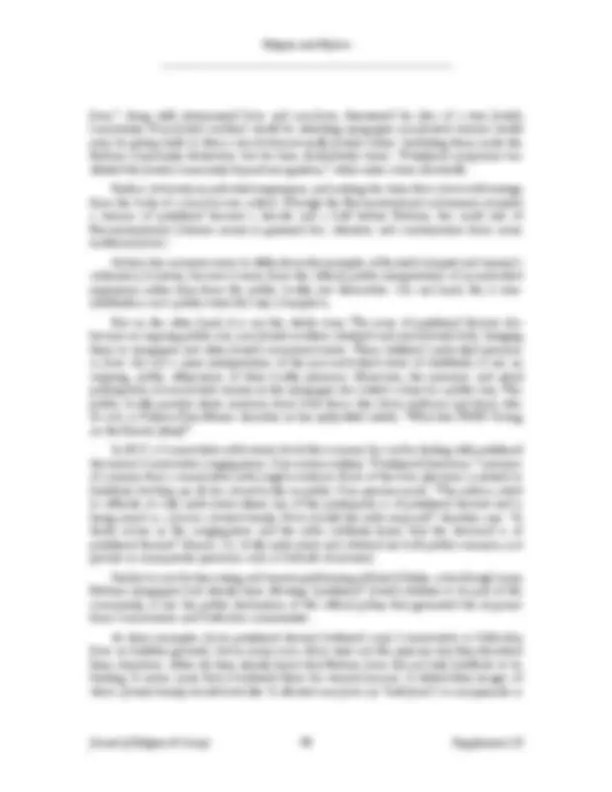
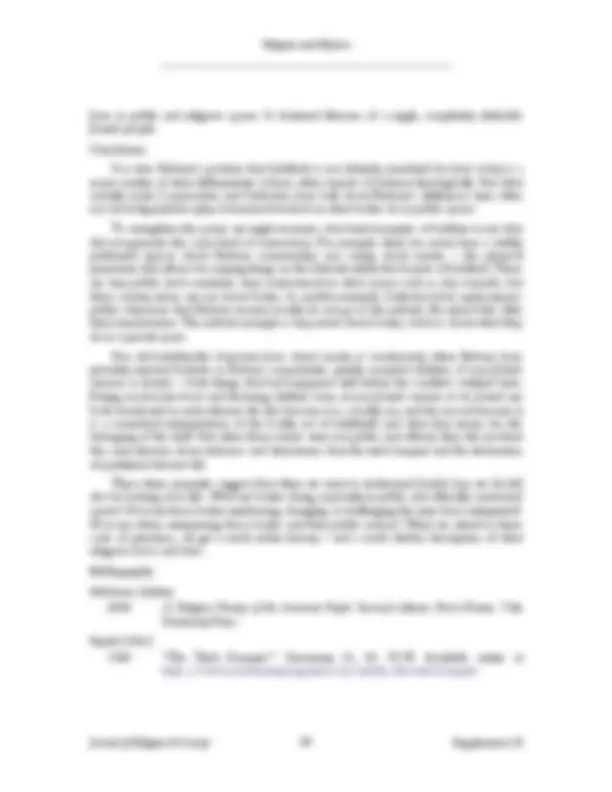
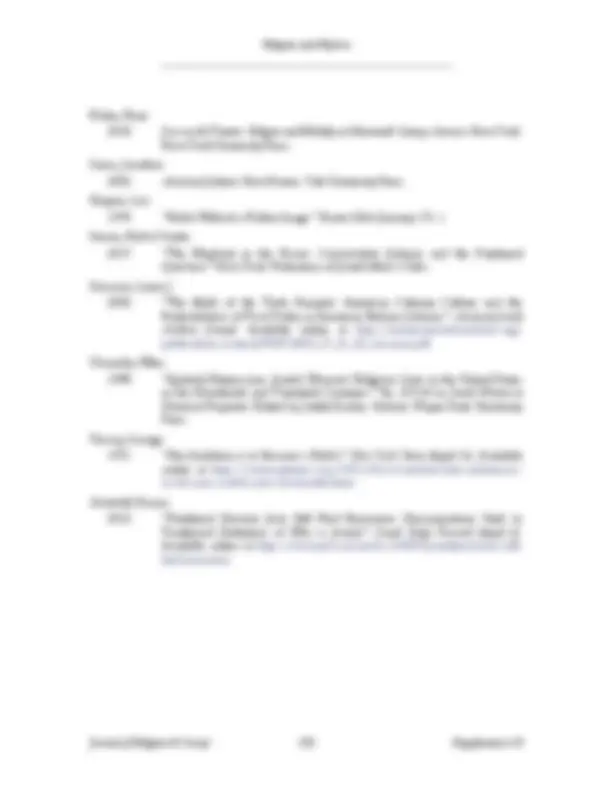


Study with the several resources on Docsity

Earn points by helping other students or get them with a premium plan


Prepare for your exams
Study with the several resources on Docsity

Earn points to download
Earn points by helping other students or get them with a premium plan
Community
Ask the community for help and clear up your study doubts
Discover the best universities in your country according to Docsity users
Free resources
Download our free guides on studying techniques, anxiety management strategies, and thesis advice from Docsity tutors
This article challenges the traditional view of Reform Judaism's distinctiveness as primarily being about its approach to Jewish law. Instead, it argues that many defining moments in Reform Judaism's history have been about public embodiment, which raises questions about the adaptability of Jewish law to the lives of Jews. various instances where Reform Jews violated Jewish law in public, leading to vocal objections from more observant Jews. These instances include interfaith marriages, non-kosher food consumption, and women serving as rabbis and chaplains.
Typology: Study notes
1 / 13

This page cannot be seen from the preview
Don't miss anything!








Edited by Ronald A. Simkins and Zachary B. Smith
Sarah Imhoff, Indiana University Abstract This article proposes a twist to the traditional halakhah-centered story of what is different about Reform Judaism: I suggest that even though we might describe American Reform Judaism’s distinctiveness as its approach to law – its conviction that Jewish law must be interpreted to fit the lives of Jews, and not the other way around – historically, many of its most defining moments have been about public embodiment. This article explores three such moments: the trefa banquet of 1883, conversations about women’s ordination, and a ruling on patrilineal descent. Although these moments were related to Jewish law in the sense that Orthodox Jews thought that each violated halakhah, there were plenty of other violations of halakhah that did not generate such vocal objection from more observant Jews, and so violation of halakhah is not sufficient explanation for why these three became defining flashpoints. I suggest that these moments had more to do with the public presence and visibility of bodies than they did with philosophical principles or liberal theology.
Keywords: Reform Judaism, embodiment, halakhah, food, women’s ordination, patrilineal descent Introduction A typical story about Reform Judaism goes like this: In the eighteenth and nineteenth century, European Jews experienced both a “Jewish Enlightenment” and emancipation. These dual forces, philosophical and social, made some European Jews question the tenets of orthodoxy. Must Jews always adapt themselves to Jewish law, or might Jewish law be adapted to Jews? Must law be the center of Judaism, or could it be ethics, belief, and community instead? Rabbi-philosophers such as Abraham Geiger sought to reform Judaism by deemphasizing and defanging law. One midrash, admittedly an atypical one for rabbinic theology, has God say: “The Sabbath is given to you, not you to the Sabbath” (Mekhilta de Rabbi Ishmael 31:13). This would have been a fitting motto for these reformers’ approach to all matters of Jewish law. Halakhah, the Hebrew word translated as Jewish law, comes from the root word for “walk” and largely governs actions (as opposed to, say, beliefs.) It is a system of rabbinic interpretations that draw on the Talmud, itself a set of interpretations and commentaries on biblical and other sources. As such, it admits differences in opinions about many topics, such as what, precisely, you can eat during Passover. Other positions, especially clear biblical prohibitions such as avoiding pork (“And the pig, because it has a cloven hoof that is completely split, but will not regurgitate its cud; it is unclean for you”; Leviticus 11:7) share widespread agreement among halakhic authorities past and present. Reform Jews, as the story goes, are distinctive because their Judaism does not position halakhah as definitive. Jewish law, as this typical story suggests, is the primary way that most people differentiate Reform Judaism from other branches, both historically and in the present. Geiger and the early German reformers made their arguments in the mid-nineteenth century. Across the ocean, the debate sounded very similar. In the 1880s, concerned about the spread of liberal Judaism, Rabbi Alexander Kohut declared that “Reform is a Deformity” because it refused the authority of Jewish law (12). Reform Rabbi Kaufmann Kohler reacted in a speech, defending Reform as a religious movement that embraced freedom “from all restrictions which curb the minds and encroach upon the hearts” (quoted in Cohen: 183). Decades later, though much had changed in the landscape of American Judaism, both Reform and non- Reform leaders still explained that Reform was different because its stance toward Jewish law was different. In 1941, Solomon Freehof said to his fellow Reform rabbis in the United States: “The difference between us [Reform Jews] and [Orthodox and Conservative Jews] is that they consider these ritual... matters as law even when they do not observe them, while we consider them as custom even when we do observe them” (290). Scholar Dana Evan Kaplan characterizes Reform Judaism as “the idea that Jews could practice their faith according to the moral precepts of Judaism but without complete adherence to the code of Jewish law” (6). As these scholars and rabbis explain, Reform Judaism reformed Judaism by demoting halakhah from its status as obligatory. In this article, however, I am proposing a twist to this traditional halakhah-centered story: I suggest that even though we might describe American Reform Judaism’s distinctiveness as
crabs, shrimp, and frogs’ legs in cream sauce, as well as beef, chicken, and ice cream. So the meal was, to put it mildly, not kosher. The menu did not have pork – one dietary restriction that some Reform Jews did follow – but it did have both milk and meat, as well as those four critters whose consumption was prohibited by Jewish law. It quickly became known as the “trefa banquet”: the non-kosher banquet. At the time it made a kerfuffle. One anonymous New York Jewish writer opined: “a painful episode was the banquet, on the menu of which, were dishes forbidden by Jewish law. Yet rabbis and laymen assembled for Jewish interests, instead of rising in a body and leaving the hall, sat down and participated.” ( New York Herald [July 22, 1883], quoted in Sussman: 34). The young Zionist leader Henrietta Szold wrote of the “indignation which was felt by a surprisingly small minority... There was no regard paid to our dietary laws” ( Jewish Messenger [July 27, 1883], quoted in Sussman: 34). When Reform leader Isaac Mayer Wise was first asked for an explanation, he said that the caterer had been asked to provide kosher food. But later, in his German language newspaper, he defended the choice to have non-kosher food. Another liberal rabbi implored American Jews to leave “kitchen Judaism to the antique cabinet where it belongs” ( Die Deborah [August 17, 1883], quoted in Sussman: 33). As the years marched on, it remained a kerfuffle in the minds of those who were there. Some did not even remember accurately; perhaps allowing the subsequent interpretations to color their memory, they elevated the event to a near-fight. David Philipson, one of the members of HUC’s first ordination class wrote in his autobiography that “terrific excitement ensued when two rabbis rose from their seats and rushed from the room. Shrimp had been placed before them as the opening course of the elaborate menu” (23). Jewish historians recount the trefa banquet as a marker of what made Reform different. Historian Jonathan Sarna describes it in detail and provides an image of its menu in his American Judaism : “Symbolically, the trefa banquet separated American Jews into two opposing camps that could not even break bread together. The incident both anticipated and stimulated further divisions” (145). Michael Meyer, historian of the Reform movement, discusses it in two separate sections of his magnum opus, Response to Modernity. American Jewish historian Hasia Diner writes of its effects dividing Orthodox Jews from more liberal Jews. She deems it a “powerful trauma” that was “offensive” to observant Jews. It “played a small but visible role in galvanizing the traditionalists,” she explains (124). Jewish Studies scholar Jordan Rosenblum writes that it “contributed to the bifurcation of American Judaism” (Rosenblum: 1). A recent podcast told listeners that it would explore “how a lavish banquet in 1883 Cincinnati kicked off a fierce debate about what it means to keep kosher. How did a dish of frogs’ legs bring about one of the largest religious arguments the U.S. has ever seen?” (Carlson). Another historian, John Appel, wrote that, far from being an error, the menu was a deliberate provocation on the part of the school’s leader, Rabbi Isaac Mayer Wise, and “was deliberately arranged by some Cincinnati businessmen.” Conservative rabbi Elliot Dorff makes a similar assertion: the banquet was “a deliberate attempt by Isaac Mayer Wise to drive the more traditional members out of the Reform camp so that he could more easily form a radical program for the Reform movement” (13). The assertion seems unlikely, but Appel and Dorff are in good company when they frame the trefa banquet as a provocative moment for Reform Judaism in the United States. The episode dramatized what was quickly becoming
clear in the late nineteenth century: Hebrew Union College would not live up to its aspirational name and represent a single, unified American Judaism after all. But this is not to say that the trefa banquet changed the face of American Judaism. Despite the fact it offended more traditional Jews and the fierce debate, the banquet did not seem to hurt the Reform movement numerically. Although a few congregations resigned from the United American Hebrew Congregations in the wake of the banquet, others joined the following year. The denomination would soon grow to be the largest in the United States. When I list this as one of Reform’s “defining moments,” then, I am not suggesting that it caused a split between Reform and what would become Conservative Judaism. Nor am I suggesting that this marks the beginning of a distinctive theological or practice-based orientation of Reform Judaism. In this sense, it was not a pivotal moment, in that no tenet or practice pivoted from before it to after it. The banquet was, however, a moment in which both Reform and non-Reform Jews were confronted with the distinctiveness of the Reform movement. It was the public and embodied character that drove this confrontation. The food at the banquet, apart from its fanciness, was not unusual for its time and its Reform attendees. In fact, Reform Jews were following a certain set of embodied norms, though not the norms of kashrut: they were eating like other upper-class Americans. Everyone involved – both Reform and Orthodox – knew that American Reform Jews did not find the laws of kashrut binding, and that Reform Jews ate non-kosher foods with frequency both in their own homes and when dining elsewhere. Dietary laws were part of the very Jewish law they had rejected. Food is important in part because it draws lines of communal belonging. As Martha Finch notes, food plays a physical role but also a symbolic one in religious life: “Not only does it provide physical nourishment and sustenance, but those who eat invest what is (and is not) eaten with deep and compelling values” (xi). This is certainly one aspect of what was going on with the outrage over the trefa banquet. And yet, Orthodox Jews did not express the same kind of focused outrage at Reform Jews’ private eating choices as they did at the banquet. Nineteenth-century American Jews who did not live in cities ate questionably kosher food (are porcupines okay? coyotes?) and certainly non-kosher meat (Rabin). Though cities were more hospitable to keeping kosher, and some Jews – women especially – developed an American kosher cuisine (Joselit: 164 - 67), even many city-dwellers sometimes ate non-kosher meat, either for reasons of finance or of halakhic apathy. Many ignored rules about mixing milk and meat, and many ate halakhically prohibited seafood. American Jews had been eating non-kosher food almost as long as there had been American Jews. With the rise of Reform Judaism, the trend increased. While Orthodox rabbis certainly did not approve, Reform eating habits had never prompted the kind of fracas that the trefa banquet did. This history suggests the objections and offense from other Jews were not solely about Reform Jews’ violation of halakhah. They were about Jews at a widely publicized and official Jewish event eating non-kosher food. Gender: Ordaining Women, 1922, 1972 When, in 1922, Martha Neumark was completing the rabbinical requirements at HUC, the Central Conference of American Rabbis (CCAR) declared that women “cannot justly be
A New York Times article described the break-up of the JWB, a formerly pan-Jewish organization: “The Jewish commission that has approved rabbis as chaplains for the United States armed forces since World War I broke up yesterday over whether a rabbi who is a woman can serve as a military chaplain.” The Times further reported: The breakup came when the nation’s major Orthodox rabbinical group, the Rabbinical Council of America, announced that it was withdrawing from the 69 - year-old Commission on Jewish Chaplaincy of the JWB because Reform Judaism independently approved a woman as a Navy chaplain... “When they endorsed a woman,” Rabbi Bernstein said of the Reform rabbinate, “we said: ‘That’s it.’ The Commission on Jewish Chaplaincy of the JWB is finished.” The decision was unanimous, he explained: “We do not want to splinter the Jewish community any further than it is,” he said. “But it is quite clear that this was imposed on us and left us with little choice. Orthodox Judaism cannot accept women rabbis” (Goldman). According to halakhah as interpreted by many Orthodox Jews, women’s bodies cannot perform commandments on behalf of men, as many Jewish liturgical contexts assume the leaders can do. So a woman cannot be counted in a prayer quorum or lead prayer publicly. According to some, even women’s voices are inappropriate in the setting of religious services. The Reform reasoning about women’s ordination similarly distanced itself from Orthodox Judaism on matters of what women’s bodies can do. Reform Rabbi David Ellenson recognized the objections of halakhically observant Jews, but nevertheless held fast to the divisive decision: “Given the overwhelming Orthodox halakhic consensus that women cannot be counted in a minyan (prayer quorum), cannot serve as shelichei tsibur (prayer leaders), may not officiate at weddings and conversions, and may not either issue a get or serve as witnesses in Jewish divorce proceeding, how could we not have anticipated that such a negative response to the issue of women as rabbis would ultimately be forthcoming from even the most moderate of Orthodox rabbinical bodies” (80). Rabbinical bodies cannot contain women’s bodies, for most Orthodox observers of halakhah. “In electing to affirm the right of women to be ordained as rabbis, our movement did depart from tradition in a serious and significant way” (80). Here too, however, women performing rabbinical duties was not new, and earlier events had not triggered the same kind of rhetoric or communal splitting. Pamela Nadell’s history of the rocky road to women’s ordination, Women Who Would Be Rabbis , hints of the rich history of American Jewish women in religious leadership. It is a telling century-long chronicle of women who fulfilled various rabbinical roles prior to Priesand’s public and official ordination: in the 1890s Ray Frank, the “girl rabbi of the west” who became known for her preaching and organizing of small Jewish communities, the learned Martha Neumark who completed seven and a half of the nine year rabbinical curriculum at HUC, Helen Hadassah Levinthal who completed the rabbinical curriculum at the Jewish Institute of Religion in New York in 1939 but was still not ordained, Paula Ackerman who became the spiritual leader of a synagogue after the 1950 death of her husband who had served as rabbi, and others. Orthodox Jewish leaders did not dissolve the JWB over these women’s activities, and they did not use these women’s preaching on Yom Kippur or even reading the Torah in front of
the congregation as a reason to “splinter” the Jewish community. Though Reform women had already been doing almost everything Reform rabbis had been doing – preaching, leadership, religious instruction, pastoral care, publicly reading from the Torah, being alone with people of the opposite sex to whom they were not married, and almost everything else except officiating at marriages and funerals (Umansky) – it was the physicality of a female body standing at the pulpit or serving as a chaplain that made more observant Jews draw the line. Birth: Patrilineal Descent, 1983 The third example of a defining moment in Reform Judaism is what is often called “patrilineal descent.” In short: unlike the halakhic rule of matrilineal descent, kids who had a Jewish father and a non-Jewish mother and participated in Jewish ritual events would be considered Jewish, with no need to convert to Judaism. In 1983, the CCAR, the Reform rabbinical association, declared that the child of one Jewish parent is under the presumption of Jewish descent. This presumption of the Jewish status of the offspring of any mixed marriage is to be established through appropriate and timely public and formal acts of identification with the Jewish faith and people. The performance of these mitzvot [commandments] serves to commit those who participate in them, both parent and child, to Jewish life. Depending on circumstances, mitzvot leading toward a positive and exclusive Jewish identity will include entry into the covenant, acquisition of a Hebrew name, Torah study, Bar/Bat Mitzvah, and Kabbalat Torah (Confirmation). The move was, in part, a response to the realities of intermarriage. Almost every Reform synagogue had intermarried couples, and many of those couples had children. Synagogues had not always warmly welcomed them, but many rabbis and congregations wanted to make them feel more included, and many intermarried couples themselves advocated for their inclusion (Mehta). It was also a statement about gender egalitarianism: the Reform movement prided itself on the equality of men and women, so why should women have to convert to Judaism if their kids were to be Jewish, when men did not have to? But if the move to patrilineal descent was designed to make things more harmonious within Reform synagogues, many non-Reform Jews complained it had the opposite effect on Reform Jews’ relationships with other Jews. The Conservative Rabbi Robert Gordis complained not because it violated halakhah, but because “of its divisiveness within the Jewish people” (Bayme: 143). A spokesperson for Agudath Israel of America, an Ultra-Orthodox group, told the Jewish Daily Forward : “Jewish movements’ attempts to tamper with the definition of Jewish status obviously carried the seeds of terrible disunity for Jews as a people” (Zeveloff). Even Reform Jews who disagree with patrilineal descent think it is a major marker of what differentiates Reform from all others. One Reform writer, commenting on demographic trends, recently wrote of his unease at the prediction that “‘the mixture of people who comprise synagogue-affiliated families will include ever-greater numbers of intermarried, non- Jews, half-Jews, and patrilineal Jews’ – the specter of which should frighten all Jewish leaders, including the most ardent advocates of patrilineality” (Bayme: 141). Patrilineal Jews and “half-
Jews in public and religious spaces. It shattered illusions of a single, completely definable Jewish people. Conclusion It is true: Reform’s position that halakhah is not divinely mandated for Jews today is a major marker of what differentiates it from other strands of Judaism theologically. But what actually made Conservative and Orthodox Jews balk about Reform’s difference were often not about legal philosophy, but instead focused on what bodies do in public spaces. To strengthen this point, we might examine a few brief examples of halakhic issues that did not generate this same kind of controversy. For example, there has never been a widely publicized uproar about Reform communities not caring about eruvin – the physical perimeters that allows for carrying things on the Sabbath within the bounds of halakhah. These are very public (and sometimes very controversial in other spaces such as city councils), but these conversations are not about bodies. In another example, Orthodox Jews rarely express public objections that Reform women usually do not go to the mikveh, the ritual bath, after their menstruation. The mikveh example is very much about bodies, but it is about what they do in a private space. Nor did halakhically observant Jews object nearly as vociferously when Reform Jews privately rejected kashrut or Reform communities quietly accepted children of non-Jewish women as Jewish – both things that had happened well before the conflicts outlined here. Eating non-kosher food and declaring children born of non-Jewish women to be Jewish are both closely tied to embodiment: the first because it is a bodily act, and the second because it is a communal interpretation of the bodily act of childbirth and what that means for the belonging of the child. But when these events were not public and official, they did not elicit the same rhetoric about divisions and divisiveness that the trefa banquet and the declaration of patrilineal descent did. These three examples suggest that when we want to understand Jewish law, we should also be looking at bodies. What are bodies doing, especially in public and officially sanctioned spaces? How are those bodies reinforcing, changing, or challenging the ways law is interpreted? How are others interpreting those bodies and their public actions? When we attend to these sorts of questions, we get a much richer history – and a much thicker description of what religious law is and does. Bibliography Ahlstrom, Sydney 2004 A Religious History of the American People. Second edition. New Haven: Yale University Press. Appel, John J. 1966 “The Trefa Banquet.” Commentary 21, 42 : 75 - 78. Available online at https://www.commentarymagazine.com/articles/the-trefa-banquet.
Bayme, Steven 2001 “Patrilineal Descent Revisited.” Pp. 137- 45 in Contemporary Debates in American Reform Judaism. Edited by Dana Evan Kaplan New York: Routledge. Butler, Judith 1993 Bodies that Matter: On the Discursive Limits of Sex. New York: Routledge. Carlson, Laura 2017 “Complicating Kosher: How the Trefa Banquet Changed American Judaism.” The Feast (Audio Podcast; October 13 ). Available online at http://www.thefeastpodcast.org/30trefa-banquet. Central Conference of American Rabbis (CCAR) 1922 “Resolution on the Ordination of Women.” Central Conference of American Rabbis Thirty Third Convention. Richmond: Old Dominion Press. 1983 “The Status of Children of Mixed Marriages, Report of the Committee on Patrilineal Descent,” adopted on March 15. Cohen, Naomi 1984 Encounter with Emancipation: German Jews in the United States. New York: Jewish Publication Society. Diner, Hasia 2004 The Jews of the United States, 1654 to 2000. Berkeley: University of California Press. Dorff, Elliot 1977 Conservative Judaism: Our Ancestors to Our Descendants. New York: United Synagogue of Conservative Judaism. Ellenson, David 2014 Jewish Meaning in a World of Choice: Studies in Tradition and Modernity. Philadelphia: Jewish Publication Society. Finch, Martha 2014 Forward to Religion, Food, and Eating in North America. Edited by Benjamin E. Zeller, Marie W. Dallam, Reid L. Neilson, and Nora L Rubel. New York: Columbia University Press. Freehof, Solomon B. 1941 “A Code of Ceremonial and Ritual Practice.” CCAR Yearbook 51. Richmond: Old Dominion Press Goldman, Ari 1986 “Issue of Women as Rabbis Breaks up Jewish Unit.” New York Times (June 18). Available online at https://www.nytimes.com/1986/06/18/us/issue-of- women-as-rabbis-breaks-up-jewish-unit.html.
Rabin, Shari 2018 Jews on the Frontier: Religion and Mobility in Nineteenth Century America. New York: New York University Press. Sarna, Jonathan 2003 American Judaism. New Haven: Yale University Press. Shapiro, Leo 1974 “Rabbi Without a Father Image.” Boston Globe (January 17): 1. Simon, Rabbi Charles 2017 “The Elephant in the Room: Conservative Judaism and the Patrilineal Question.” New York: Federation of Jewish Men’s Clubs. Sussman, Lance J. 2005 “The Myth of the Trefa Banquet: American Culinary Culture and the Radicalization of Food Policy in American Reform Judaism.” American Jewish Archives Journal. Available online at http://americanjewisharchives.org/ publications/journal/PDF/2005_57_01_02_sussman.pdf. Umansky, Ellen 1998 “Spiritual Expressions: Jewish Women’s Religious Lives in the United States in the Nineteenth and Twentieth Centuries.” Pp. 337-64 in Jewish Women in Historical Perspective. Edited by Judith Baskin. Detroit: Wayne State University Press. Vecsey, George 1971 “Her Ambition is to Become a Rabbi.” New York Times (April 13). Available online at https://www.nytimes.com/1971/04/13/archives/her-ambition-is- to-become-a-rabbi-and-a-housewife.html. Zeveloff, Naomi 2012 “Patrilineal Descent Jews Still Find Resistance: Denominations Stick to Traditional Definition of Who is Jewish.” Jewish Daily Forward (April 2 ). Available online at https://forward.com/news/154009/patrilineal-jews-still- find-resistance.